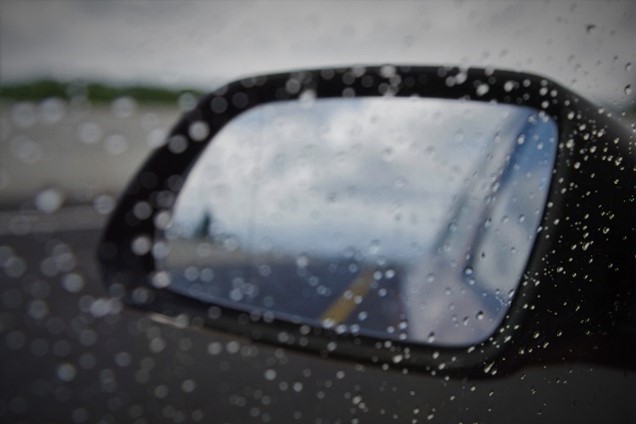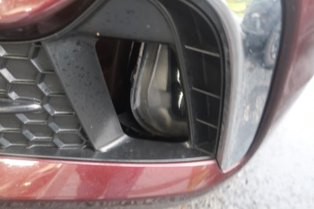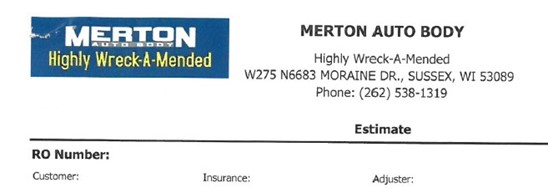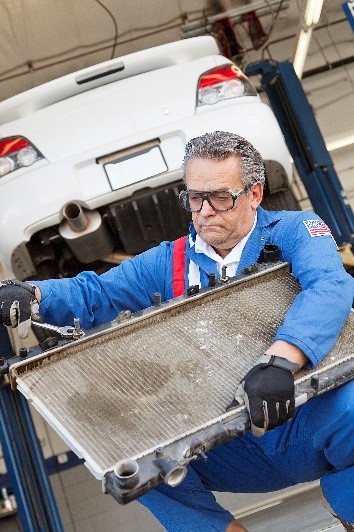It’s a cold, rainy, dark fall evening. I am coming home from work and traveling from the “city” to the country. Wisconsin is abundant with deer so I am constantly scanning the roads and ditches looking for the glowing eyes of deer.
In an instant and out of nowhere, the headlamps catch a glimpse of large glowing dark eyes. Instinctively I slam on the brakes but do not swerve. Then I hear and feel the impact. The sound is indescribable, all your senses are alive and screaming at you. Am I hurt? What do I do? Did I just get in an accident? What did I hit?
Your adrenaline instinctively takes over. One minute I am fine, the next I am at a dead stop in the middle of the road.
Insurance Mode: Did you know that you are 3.5 more likely to hit a deer in November than ANY other time of the year because of the mating season? Each year there are more than 260,000 animal collisions. Along with mating season, Daylight Savings time means more time spent driving in the dark.

Slowly my mind calms and I know I have hit a deer. I see the deer right below my driver’s mirror. We are looking at each other startled and stunned.
Slowly, my awareness comes back to me. I realize I am at a dead stop on a very dark, busy road, with no streetlights. I can hear the rain softly hitting my car and the low sounds of the radio station.
My first thoughts are “What do I do now? Am I hurt? Is the deer hurt? What if it charges my car and breaks through my window? Wait, is my car drivable? I need to call my husband Steve- he will know what to do.”
I pick up my phone and dial. In a panicked voice I say- “I hit a deer and I don’t know what to do” totally expecting my husband to know exactly what to do and where I am. Just then my brain comes back.
“Move the car, Cheryl.”
“Get out of the road, Cheryl.”
“Pull over to safety, Cheryl.”
My next thoughts are:
“Why didn’t the airbags go off? Boy am I lucky. Wait-where is the deer? Is it in the middle of the road? I think I can drive my car to my house, will it blow up?” Your mind is moving in a million different directions all at once.

My husband is trying to help by figuring out where I am and how severe the situation is. I inch the car slowly forward moving towards the direction of my house all while trying to re-compose myself and control my breathing. Calm yourself. You are fine, you are safe, it is just a car.”
Once the shock wears off the next emotion sets in. Oh no… insurance. Is this a claim? Will it be covered? How do I decide if I should pay for the damage out of pocket or submit a claim? Will this affect my rates?
Insurance Mode: Auto insurance is there to cover your bills after an accident.
Three tips to help you stay safe on the road:
- Be an attentive driver. Stay alert, drive defensively, and watch your speed. Use your high beams whenever possible at night.
- Look for Signs. Wildlife signs are posted in areas that are prone to wildlife crossing. Deer are most active at both dusk and dawn.
- Be Smart. If you do see a deer or wildlife, try to avoid swerving to get out of their way. Use your brakes and maintain control of your vehicle.

Auto insurance is meant to protect you by covering your bills after an accident. However, the amount of compensation can vary depending on your policy, the type of claim and the value of your vehicle.
My insurance agent hat is back on, I can think critically and know how to respond.
So, what do you do if you hit a deer?
Step 1: Get an estimate. You need the facts, what is damaged, what needs repair, and how much it is going to cost. Take lots of pictures.
The next morning, we headed off to Merton Auto Body for an estimate.

They take pictures, and measurements, and tally the “tentative total.” In our case, we have a vehicle that has sensors everywhere. The physical damage is the “easy” repair. Technology is a beautiful thing, and our vehicles are much safer than they once were. We have all kinds of safety features. The bulk of our repair will be the sensors, headlights and re-calibration of the cameras.
Our repair bill will start at $2700.
After you have the estimate, this is a great time to reach out to your agent. Since I am an agent, I weighed our options and decided to submit the claim. Ultimately, I decided to submit the claim because of the sensor damage and recalibration.
With my pictures and estimate in hand, I reach out to our carrier and start the claim. I tell the claims department what happened, the condition of the car, and where the car is. The person gives me the claim number and asks if I need a rental car. At this point, I decline the car to “wait and see what happens.” Within 24 hours, I can expect a call from a claims adjuster.
A Deer hit me and now have an insurance claim
When you hit a deer- it is called a “comprehensive” claim, often the deductible is different than a collision claim.


When we selected the policy, I elected to have a higher deductible so I would have a smaller premium without sacrificing coverages. When you have a claim, this is where you will find out if your insurance is good.
A deductible is the amount of money you are going to pay in the event of a claim. They can be any amount but typically on an auto policy, the deductible will start at $500. In my claim, I do have a $500 deductible so, of our $2700 estimate, we will pay $500 and the insurance company will pay $2200.
Clues on how “good” your insurance carrier is:
- How responsive is the adjuster?
- Can I go to the body shop of my choosing?
- Do I have rental car coverage?
- What if my car has a very long repair time?

Our adjuster called me the same day as I submitted the claim. Since I already had the estimate and pictures, she was able to make decisions as we spoke. She confirmed I was not injured and that I did not hit any type of property (telephone poll, another vehicle, guard rail, fence….) Nope just a deer. She approved the estimate, mailed the check, and reached out to the body shop. She also confirmed what I had already been hearing. Expect long delays, part shortages and rental car scarcity and higher pricing. Lastly our adjuster informed me that often the sensors need more work than the pictures/estimate show. And if the auto body finds more extensive damage, they will send out a supplemental payment. She will leave the claim open until our vehicle is repaired.
Time to call the auto body shop to schedule an appointment.
A deer hit me and now have to “deal” with insurance and an auto body Shop.
The next call is to the auto body shop. It is Oct 29, 2022 and I was just informed it would be the end of December before they could repair the car. Oh well, at least the insurance process was easy!
Insurance Mode: What to expect in our supply chain stressed world:

- Long delays in repair appointments.
- Parts and labor are in short supply.
- If the part says a particular date, you probably should add more days/weeks to the timeline.
- Rental cars are scarce and come with a premium price tag.
- If you have rental car coverage on your insurance policy, it not only has a dollar limit but a time element as well.
Does your policy have enough rental car coverage or glass coverage? It is my experience that most people subtract this coverage to save a few premium dollars. My claim will need rental coverage from the end of October to the end of December. As with most policies, my coverage only has 30 days of rental coverage. Pre-pandemic, 30 days would be more than enough. In today’s world, it is not enough. This is something that will have to adjust going forward. For now, we think outside the box.
I hit a deer and now I am impatient.
If you remember, I now have a claim, a long repair lead time, and only 30 days of rental coverage. What do I do? My car is drivable but the more I drive it the more damage could happen. So, I call our local dealership and ask if they have any headlights in stock. With luck, they do! I purchased the light and paid the dealership. It was $500, I could safely drive my car and it wouldn’t create more damage.
Insurance mode: Did you know that you have the right to “preserve” your property from further damage?
I called the auto body shop and told them I was able to obtain a headlight and that they didn’t have to order one. This also took some of the stress off of timing. Fast forward to November and December. It’s January 2022, a little less than 90 days after the deer hit. It is finally my time to get the car repaired. Elated, overjoyed, and ready to be done with this. I am told it should take 7 to 10 days to finish the car. Shortly after it arrived, they noticed more damage and were able to contact our adjuster with the new totals. New totals were approved, the check was mailed, and repairs continued. The final bill ended up being nearly $4,000.
I hit a deer and now I am worried my rates will increase.
Insurance Mode: Good news! Because it was a “comprehensive claim” meaning an incident caused by something outside your control it isn’t looked at as something bad. It just is. Often, your insurance rates are not impacted by these types of claims. A caveat is, if you lock your keys in your car often and use insurance because you have roadside assistance, this will impact rates. The frequency of comprehensive claims does impact rates.
So, what did I learn from hitting a deer? Claims are always stressful but having great insurance makes the situation a lot less dramatic. People often tell me they do not need a particular coverage but here’s the thing… we don’t know when something is going to happen to us. If we did, it wouldn’t be called an accident. After going through a tornado in 2008, I am in the camp of getting all the insurance I can afford, and I hope I will never have to use it. I like knowing if I am in trouble, I will have a rock star team surrounding me. And even a husband who knows how to use “Find my iPhone” and tells me I am 200 feet from our home and to drive there.
Be safe out there. Watch for animals. Don’t swerve. Get your insurance policy reviewed. Don’t buy the minimum coverage.
